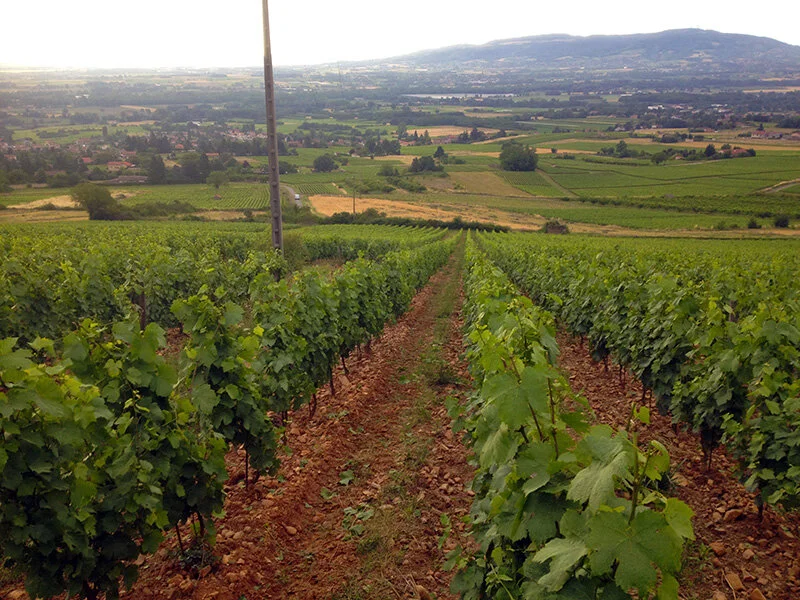domaine saint-cyr
Raphaël Saint-Cyr
anse
Beaujolais - France
story…
Four generations of the Saint-Cyr family have been vignerons in Beaujolais; founded originally by Raphaël’s great-grandfather and until recently was known as Domaine de Bellevue. The domaine is based in the southern reaches of Beaujolais, where quality is rarely the focus for most domaines but Raphaël is set on changing that mindset. He took the reins at the family estate in 2008 and set straight to work on bringing the domaine and vineyards up to speed.
He first focused in on the vineyards and farming, letting go of a fair amount of their holdings in and around their estate, except for some key old vine vineyard planted by his grandfather in the 50’s. He then started acquiring vineyard parcels in some of the more lodded Cru’s of the north including: Morgon, Chénas, and Moulin-á-Vent. Once he had all of his vineyard holdings lined up, he began the laborious task of converting them all to organic farming. This may seem like a no brainer for the Beaujolais region, and for the Crus of the north it has certainly become more commonplace, however in the south Raphaël is one of just a handful of growers dedicated to organics or any type of more sustainable farming. Fortunately this number is growing, with the success of producers like Saint-Cyr and a few others many growers are seeing the beneficial payoff of working in this manner.
philosophy…
Raphaël’s philosophy, both in the vineyards and cellar, are in line with what you might expect from a quality producer based in Beaujolais these days. His decision to convert to organics wasn’t just choice, he felt that it was more like an obligation to himself, his family and those around him. Having witnessed close family relatives get sick from the use of chemicals to treat their vines he couldn’t stomach the idea of continuing that type of farming. All 23 hectares of his vines are certified organic (since 2012), which makes Saint-Cyr one of the largest in all of Beaujolais with this certification. He also employs some biodynamic practices in his vineyards.
In the cellar the production is quite traditional, all of the reds go through a cold carbonic maceration. When Raphaël first came on this wasn’t the case but after doing an experimental batch of his Chénas in this manner he loved the outcome and has now converted all of his red production to include cold carbonic maceration. Fermentations take place on native/ambient yeasts and are typically done in tank for both red and whites. The reds are aged generally in a mix of concrete and wood or exclusively in wood depending on the cuvée and/or the vintage. His rosé is the only wine done entirely in stainless steel tank from start to finish; his excellent white is fermented and aged entirely in barrel.
Vineyards…
The domaine consists of 28 total hectares of vines, the majority of which are located in the southern reaches of Beaujolais near where their estate is located. The vineyards located around the estate consist of 20 hectares of vines, 6 of which are planted to Chardonnay, the remainder is planted to Gamay. The remaining 8 hectares of vines are located in the north in the crus of Morgon, Chénas, Fleurie, and Moulin-à-Vent. The main difference between the crus of the north and the vineyards in the south is the main soil composition. Where in the crus the dominant soil is granite, the dominant soil in the south is limestone.
Lachassagne
a .5 ha single parcel of Chardonnay planted in the 1950’s | located in Anse near the estate | clay limestone soils with active calcareous marl | double guyot trained vines
Terroir de Bellevue
a 3 ha parcel of Gamay planted in the 1950’s by Raphaël’s grandfather | clay heavy, limestone soils | guyot trained vines
Chénas “Les Blémonts”
Raphaël owns a 3.5 ha parcel in this single vineyard site located in the center of Chénas | vines were planted in the 1920’s & 1970’s | granite soils with abundance of white granite and round stones | gobelet trained vines
Chénas “Les Journets”
a 1.5 ha parcel of vines that are a prolongation of Raphaël’s “Les Blémonts” vineyard | vines planted in the 1950’s, 60’s & 70’s | white granite soils | gobelet trained vines | first bottled on its own in 2017
Morgon “Les Charmes”
Raphaël has 1 ha of vines in this famous site in Morgon | vines are at 500 masl, making it his highest elevation parcel | vines were planted in 1954 | white granite with red schist soils | gobelet trained vines
Moulin-à-Vent “La Bruyère”
Raphaël has a 1.4 ha parcel of vines in this single vineyard site | pink granite soils | vines planted in 1960’s & 90’s | gobelet trained vines

